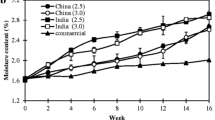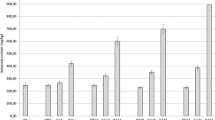Abstract
Storage conditions are key constraints for quality assurance of the shea (Vitellaria paradoxa Gaertner) butter. In the Sudan savannah Africa, storage conditions of butter produced by women vary across and among processors, traders and consumers. These conditions could impact the quality of the products and reduced their access to international market. The present study attempted to investigate the effect of storage duration and packaging materials on microbiological and physicochemical characteristics of shea butter under tropical climatic conditions. Five packaging materials traditionally used in shea butter value chain were tested for their efficacy in storing shea butter freshly produced. Total germs, yeasts and mould varied with packaging materials and storage duration. After 2 months of storage, moisture content of butter remained constant (5%) whereas acid value increased from 3.3 to 5.4 mg KOH/g, peroxide value from 8.1 to 10.1 meq O2/kg and iodine value dropped from 48.8 to 46.2 mg I2/100 g in shea butter irrespectively to the storage materials used. The basket papered with jute bag was the less effective in ensuring the quality of butter during storage while plastic containers and plastic bags seemed to be the best packaging materials.
Similar content being viewed by others
References
Abdulrahim MO, Hassan A, Bahago EI (2000) Practical manual on food technology, nutritional dietetics for schools and industries. Paper presented in the Proceedings of the National Science and Technology Forum, College of Science and Technology, Kaduna Polytechnic, Kaduna, Nigeria
Alander J (2004) Shea butter—a multifunctional ingredient for food and cosmetic. Lipid Technol 16(9):202–205
Anhwange BA, Ajibola VO, Oniye SJ (2004) Chemical studies of seeds of Moringa oleifera and Detarium microcarpum (Guill and Sperr). J Biol Sci 4(6):711–715
AOAC (2002) Official methods of analysis, 16th edn. Association of Official Analytical Chemists, Washington
Chukwu O, Adgidzi PP (2008) Evaluation of some physico-chemical properties of Shea-butter (Butyrospermum paradoxum) related to its value for food and industrial utilisation. Int J Postharvest Technol Innov 1(3):320–326
CNUCED (2006) Le karité: production, consommation et marché. http://www.unctad.org/infocomm/français/karité/marché.htm. (Accessed on 21 July 2009)
Codex Alimentarius (1992) Programme mixte FAO/OMS sur les normes alimentaires. FAO, Rome
Dhellot JR, Matouba E, Maloumbi MG, Nzikou JM, Safou-Ngoma DG, Linda M, Desobry S, Parmentier M (2006) Extraction, chemical composition and nutritional characterization of vegetable oils: case of Amaranthus hybridus (Var1 and 2) of Congo Brazzaville. Afr J Biotechnol 5(11):1095–1101
Elias M, Carney J (2004) La filière féminine du karité: productrice burkinabée, «éco-consommatrices» occidentales et commerce équitable. Cah Geogr Que 48(133):1–26
Ernest H (2001) Un commerce qui aide les femmes pauvres au Burkina Faso. Afr Relance 15(4):6–7
FAO (1979) Manuals of food quality control and food analysis, quantity adulteration and test of identity, Food and Agriculture Organization, Food Nutr paper 14/8, United Nations, Rome, pp 255–290
Hall JB, Aebischer DP, Tomlinson HF, Osei-Amaning E, Hindle JR (1996) Vitellaria paradoxa. School Agric Forest Sci Publication, University of Wales, Bangor 8, pp 1–105
Hui L (1996) Edible oil and fat products: oils and oilseeds, bailey’s industrial oil and fat products, 5th edn. Wiley, New York, pp 109–110
Hultin HO (1992) Lipid oxidation in fish muscle. In: Flick GJ, Martin RE (eds) Advances in seafood biochemistry: composition and quality. Technomics Publishing Compagny Inc, Lancaster, pp 99–122
Kapseu C, Womeni HM, Ndjouenkeu R, Tchouanguep MF, Parmentier M (2005) Influence des méthodes de traitement des amandes sur la qualité du beurre de karité. Proc Biol Alim 3:1–18
Kirk RS, Sawyer R (1991) Pearson’s composition and analysis of foods. Longman Scientific and Technical, Harlow, pp 609–617
Letchamo W, Khoo BK, Hartman TG (2007) Evaluation of the quality of West African shea butter (Vitellaria paradoxa). Int Soc Hortic Sci 756:273–288
Louppe D (1995) Le karité en Côte d’Ivoire. Report of the Forestry Institute of Côte d’Ivoire (IDEFOR) 19p
Maranz S, Kpikpi W, Weisman Z, Sauveur AD, Chapagain B (2004) Nutritional values and indigenous preferences for shea fruits (Vitellaria paradoxa CF Gaertn.) in African agroforestry parklands. Econ Bot 58:588–600
Megnanou RM, Niamke S, Diopoh J (2007) Physicochemical and microbiological characteristics of optimized and traditional shea butters from Côte d’Ivoire. Afr J Biochem Res 14:41–47
Mittal GS, Paul S (1997) Regulating the use of degraded oil/fat in deep fat/oil food frying. Critical Reviews Food Sci Nutr. 37:635-662.
Moharram H, Ray J, Ozbas S, Juliani H, Simon J (2006) Shea butter: Chemistry, quality, and new market potentials. American Chemical Society Symposium 925, pp 326–340
NB ISO 3657 (2006) Normes Béninoises pour les corps gras d’origine animale et végétale: détermination de l’indice de saponification. CEBENOR (Centre Béninois de Normalisation), p 9
NB ISO 3960 (2006) Normes Béninoises pour les corps gras d’origine animale et végétale: détermination de l’indice de peroxyde. CEBENOR (Centre Béninois de Normalisation), p 9
NB ISO 3961 (2006) Normes Béninoises pour les corps gras d’origine animale et végétale: détermination de l’indice d’iode. CEBENOR (Centre Béninois de Normalisation), p 8
NB ISO 660 (2006) Normes Béninoises pour les corps gras d’origine animale et végétale: détermination de l’indice d’acide et de l’acidité. CEBENOR (Centre Béninois de Normalisation), p 13
NBF 01-005 (2006) Normes Burkinabées pour le beurre de karité non raffiné. ABNOR (Agence Burkinabée de normalisation), p 21
Schreckenberg K (2004) The contribution of shea butter (Vitellaria paradoxa C.F. Gaertner) to local livelihoods in Benin. In: Sunderland T, Ndoye O (eds) Forest products, livelihoods and conservation. CIFOR, Indonesia, pp 91–113
Tchobo FP, Natta AK, Barea B, Barouh N, Piombo G, Pina M, Villeneuve P, Soumanou MM, Sohounhloue DCK (2007) Characterization of Pentadesma butyracea sabine Butters of different production Regions in Benin. J Am Oil Chem Soc 84:755–760
Womeni HM, Ndjouenkeu R, Kapseu C, Fanni JJ, Parmentier M (2006) Application du procédé séchage friture aux amandes de karité: influence sur les indices chimiques de qualité et les propriétés. OCL 13:297–302
Acknowledgements
This research was supported by the International Institute of Tropical Agriculture and the “Institut National de Recherches Agricoles du Bénin”, through STDF 48 project, financed by FAO. Many thanks are going to all people who gave their help during the laboratory analysis.
Author information
Authors and Affiliations
Corresponding author
Rights and permissions
About this article
Cite this article
Honfo, F., Hell, K., Akissoé, N. et al. Effect of storage conditions on microbiological and physicochemical quality of shea butter. J Food Sci Technol 48, 274–279 (2011). https://doi.org/10.1007/s13197-010-0150-x
Revised:
Accepted:
Published:
Issue Date:
DOI: https://doi.org/10.1007/s13197-010-0150-x




